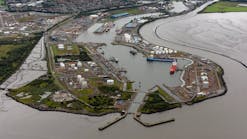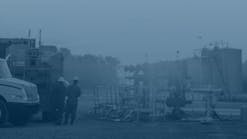Full scale efforts to extinguish Kuwait's oil well fires are to begin this month.
The campaign to combat history's worst oil fires, originally expected to begin in mid-March, has been hamstrung by logistical problems, including delays in equipment deliveries caused by damage to Kuwait's infrastructure.
Meantime, production from a key field off Kuwait-largely unaffected by the war - is expected to resume in May, but Kuwaiti oil exports will still be hindered by damaged onshore facilities.
In addition, Kuwait is lining up equipment and personnel to restore production from its heavily damaged oil fields.
Elsewhere in the Persian Gulf, Saudi Arabia reports progress in combating history's worst oil spills but acknowledges a continuing threat.
FIREFIGHTING EFFORTS
Wild well specialists' initial efforts in the campaign to extinguish Kuwait's estimated 600 well fires, thought to be burning about 4-6 million b/d of crude, were hampered by limited water supplies.
It will take more than a month to lay a water pipeline to the Persian Gulf to provide an unlimited water supply for firefighting efforts, and the pipeline route will have to first be cleared of unexploded ordnance. According to press reports, Bechtel Corp. told wild well specialists they were to have 4,000 gal/min of water deliverability by Apr. 5 via a converted crude pipeline to the seaport of Faheel. Wild well specialists late last month were unsuccessful in first efforts to douse flames with water pumped at 600 gal/min from Kuwaiti fire trucks.
Middle East sources report firefighting teams and other companies involved in restoring Kuwait's oil facilities expect improvement in equipment deliveries once direct air links are reestablished and more cargoes start to pass through the port at Shuaiba.
Shuaiba was less damaged than other import facilities in Kuwait. The port reopened Mar. 12, but facilities remain limited. Currently, equipment is entering Kuwait over the Saudi border, resulting in frequent delays.
Kuwait also has reorganized the supervisory system for reconstruction work. A layer of bureaucracy has been removed, giving customers and suppliers closer contact with Kuwait Petroleum Co. management.
RENEWED PRODUCTION
In the Kuwaiti portion of the Neutral Zone, the Japanese operated Arabian Oil Co. said production from Khafji offshore field should resume by the end of May.
Khafji field was not damaged during the war and is capable of producing about 250,00-270,000 b/d, but exports can't resume until onshore facilities are fully operational again.
Iraqi artillery damaged nearby storage tanks and some administrative and accommodation facilities. These must be repaired and minor work carried out on tanker export facilities.
DRILLING SERVICES, RIGS
Smith International Inc., Houston, signed a contract and received letters of credit from Kuwait to provide personnel and services to drill relief wells.
A multiwell, multimillion dollar contract calls for Smith to provide experienced directional drilling personnel and a wide range of downhole equipment capable of intersecting one or more blowouts at depths of 4,000-14,000 ft.
In addition, Kuwait Petroleum Co. subsidiary Santa Fe International Corp., Alhambra, Calif., is to send a fleet of eight land rigs to Kuwait.
The first Santa Fe rig destined for Kuwait left Houston Mar. 27. It is rated to 20,000 ft and due in Kuwait the first week of May.
A second rig, rated to 25,000 ft, is being rigged up for shipment May 6. The others will come from Egypt, Oman, and Qatar.
SPILL UPDATE
Saudi Arabia's Meteorological and Environmental Protection Agency (MEPA) says about 100 b/d of crude oil is still spilling into the Persian Gulf from a damaged tanker off Kuwait and from the Mina al-Bakr tanker terminal off Iraq.
A survey of the northern gulf by a Japanese team also shows minor seeps of oil from the Sea Island terminal off Ahmadi. The Japanese team also estimated the Sea Island spill is 3-4 million bbl and will take as long as 2 years to disperse.
Saudi Arabia's Alwassit oil recovery vessel has recovered the last remaining oil spilled from Khafji storage facilities. About 220,000 bbl of emulsion was picked up by the vessel and transshipped to other units for oil recovery.
Now that the immediate threat from the Khafji spill has disappeared, coastal containment/cleanup units are tracking oil from a large slick that has been trapped and is stationary behind Abu Ali and Abu al-Batina islands.
Wind and currents are moving the oil slowly south toward Jubail. Vacuum tankers and skimmers deployed by MEPA and Saudi Aramco Oil Co. are picking up 30,000 b/d of oil emulsion.
Copyright 1991 Oil & Gas Journal. All Rights Reserved.


